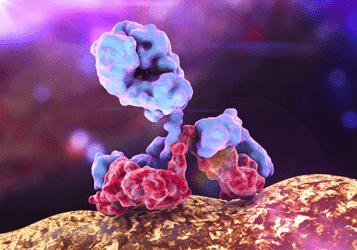- Home
- Products
- Anti-Ab ADCs
- IgG Fab
- anti-HIgG(Fab)-N-DM1 ADC
anti-HIgG(Fab)-N-DM1 ADC (CAT#: ADC-AA-018)
This ADC product is comprised of an anti-human IgG Fab specific polyclonal antibody conjugated via a noncleavable linker to DM1. The antibody portion is a secondary antibody and the drug portion, DM1, is a cytotoxic small molecule which binds to tubulins, interrupts microtubule dynamics, and induces cell death. This product displays no obvious toxicity without a primary antibody and can be a quite efficient and economical alternative to pre-screening human monoclonal antibodies as ADC candidates.
- ADC Target
- ADC Antibody
- ADC Linker
- ADC payload drug
- Name
- IgG Fab
- Overview
- The fragment antigen-binding (Fab) fragment is a region on an antibody that binds to antigens. It is composed of one constant and one variable domain of each of the heavy and the light chain. The variable domain contains the paratope (the antigen-binding site), comprising a set of complementarity determining regions, at the amino terminal end of the monomer. Each arm of the Y thus binds an epitope on the antigen
- Overview
- anti-human IgG Fab specific polyclonal IgG antibody
- Species Reactivity
- Human
- Name
- Noncleavable linkers
- Description
- Noncleavable linkers, is considered noncleavable-meaning linker cleavage, and payload release does not depend on the differential properties between the plasma and some cytoplasmic compartments. Instead, the release of the cytotoxic drug is postulated to occur after internalization of the ADC via antigen-mediated endocytosis and delivery to lysosomal compartment, where the antibody is degraded to the level of amino acids through intracellular proteolytic degradation.
- Name
- DM1 (N2’-Deacetyl-N2’-(3-mercapto-1-oxopropyl)maytansine)
- Description
- Derived from Maytansinoid,a group of cytotoxins structurally similar to rifamycin, geldanamycin, and ansatrienin. The eponymous natural cytotoxic agent maytansine is a 19-member lactam (ansa
macrolide) structure originally isolated from the Ethiopian shrub Maytenus ovatus. Maytansinoids can bind to tubulin at or near the vinblastine-binding site, which interfere the formation of microtubules and depolymerize already formed microtubules, inducing mitotic arrest in the intoxicated cells.
For Research Use Only. NOT FOR CLINICAL USE.
Related Products
- anti-Rat IgG(HL)Fab-C-MMAF ADC (CAT#: ADC-AA-047)
- anti-HIgG(Fc)Fab-N-DM1 ADC (CAT#: ADC-AA-015)
- anti-HIgG(Fab)-C-MMAE ADC (CAT#: ADC-AA-017)
- anti-RIgG(HL)-N-MMAF ADC (CAT#: ADC-AA-034)
- anti-MIgG(Fc)-C-MMAF ADC (CAT#: ADC-AA-020)
- anti-RIgG(HL)Fab-N-MMAF ADC (CAT#: ADC-AA-037)
- Anti-HIgG(Fab)-N-MMAF ADC (CAT#: ADC-AA-063)
- anti-MIgG(Fc)-N-DM1 ADC (CAT#: ADC-AA-026)
- anti-RIgG(Fc)-N-MMAF ADC (CAT#: ADC-AA-032)
- anti-Rat IgG(Fc)Fab-C-MMAE ADC (CAT#: ADC-AA-043)
Published Data
+ Submit Publications

Scientific Resources
Customer Reviews and FAQs
There are currently no Customer reviews or questions for ADC-AA-018. Click the button above to contact us or submit your feedback about this product.
Customer Reviews
FAQ

Excellent
Anti-HIgG(Fab)-N-DM1 ADC offers unparalleled precision in targeting microtubules. This product's efficacy in inducing cell death while minimizing toxicity is exceptional.

Excellent
Creative Biolabs' anti-HIgG(Fab)-N-DM1 ADC is groundbreaking. Its ability to disrupt microtubule dynamics precisely without primary antibodies simplifies our pre-screening process.

Excellent
Impressed by the delivery mechanism of this ADC! The noncleavable linker ensures DM1 remains effective, providing consistent results in our cytotoxicity assays.

Excellent
Reliable and potent, the Anti-HIgG(Fab)-N-DM1 ADC targets cancer cells effectively, demonstrating significant results in microtubule disruption and subsequent cell death.

Excellent
A robust tool for monoclonal antibody screening. Anti-HIgG(Fab)-N-DM1 ADC's precise binding and potent cell-killing capacity make it indispensable for our research.
Quick Links
Other Products
Same Target
Same Linker
Same Payload
| CAT# | Product Name | Linker | Payload |
| ADC-AA-017 | anti-HIgG(Fab)-C-MMAE ADC | Cleavable linkers | MMAE (Monomethyl auristatin E) |
| ADC-AA-064 | Anti-HIgG(Fab)-C-MMAF ADC | Cleavable linkers | MMAF |
| ADC-AA-063 | Anti-HIgG(Fab)-N-MMAF ADC | Noncleavable linkers | MMAF |
| CAT# | Product Name | Linker | Payload |
| ADC-AA-026 | anti-MIgG(Fc)-N-DM1 ADC | Noncleavable linkers | DM1 (N2’-Deacetyl-N2’-(3-mercapto-1-oxopropyl)maytansine) |
| ADC-AA-037 | anti-RIgG(HL)Fab-N-MMAF ADC | Noncleavable linkers | MMAF (Monomethyl auristatin F) |
| ADC-AA-046 | anti-Rat IgG(HL)Fab-N-MMAF ADC | Noncleavable linkers | MMAF (Monomethyl auristatin F) |
| ADC-AA-045 | anti-Rat IgG(HL)-N-MMAF ADC | Noncleavable linkers | MMAF (Monomethyl auristatin F) |
| ADC-AA-034 | anti-RIgG(HL)-N-MMAF ADC | Noncleavable linkers | MMAF (Monomethyl auristatin F) |
| CAT# | Product Name | Linker | Payload |
| ADC-AA-008 | anti-HIgG(Fc)-N-DM1 ADC | Noncleavable linkers | DM1 (N2’-Deacetyl-N2’-(3-mercapto-1-oxopropyl)maytansine) |
| ADC-W-495 | Anti-EGFR-SMCC-DM1 ADC-4 | SMCC (N-succinimidyl 4-(Nmaleimidomethyl)cyclohexane-1-carboxylate) | DM1 (N2’-Deacetyl-N2’-(3-mercapto-1-oxopropyl)maytansine) |
| ADC-W-487 | Anti-CD70-MCC-DM1 ADC | MCC (Maleimidomethyl cyclohexane-1-carboxylate) | DM1 (N2’-Deacetyl-N2’-(3-mercapto-1-oxopropyl)maytansine) |
| ADC-W-496 | Anti-EGFR-SMCC-DM1 ADC | SMCC (N-succinimidyl 4-(Nmaleimidomethyl)cyclohexane-1-carboxylate) | DM1 (N2’-Deacetyl-N2’-(3-mercapto-1-oxopropyl)maytansine) |
| ADC-W-572 | Anti-ERBB2 (Trastuzumab-Fab)-SPP-DM1 ADC | SPP (N-succinimidyl-4-(2-pyridyldithio)pentanoate) | DM1 (N2’-Deacetyl-N2’-(3-mercapto-1-oxopropyl)maytansine) |
Online Inquiry
Welcome! For price inquiries, please feel free to contact us through the form on the left side. We will get back to you as soon as possible.



